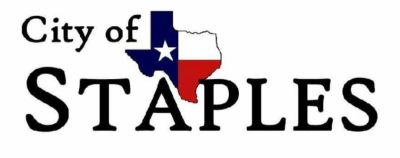History
Staples, TX. on the San Marcos River in northeastern Guadalupe County, is located at the intersection of State Highway 621 and County Road 1977. Some of the earliest settlers were the McKean brothers, John and William, who arrived in the vicinity in 1852. They were later joined by the families of Leonidas Hardeman, Stokely Holmes, J. G. Lilley, Hedley Polk, John D. Staples, Nelson Tuttle, and Robertson Waller. In 1861 Camp Edward Clark, a Confederate regimental training site, was located in the area. Here Capt. Stokely Holmes organized an infantry company of local recruits that became part of Col. Peter C. Woods's regiment. In 1867 Leonidas Hardeman harnessed the waterpower of the San Marcos River to operate a cotton gin. Subsequent owners of the gin used waterpower in the off season to grind corn, saw lumber, and crush sugar cane. At the turn of the century the turbine was supplemented with steam power during periods of low river flow.
In 1871 Civil War veteran Col. John Douglas Staples established a country store in a live oak grove on the George Allen league, 500 yards from Hardeman's cotton gin. On May 19, 1879, a post office was opened there. The place was called Staples Store until 1891, when the post office department dropped "Store" from the designation. The office and its duties were passed about frequently for the first half century of its existence. The postmaster was usually a business owner who was willing to house the postal operation as a part-time duty. Initially, the Staples office was served by rerouting the twice-weekly Luling–San Marcos mail run along the San Marcos River between Prairie Lea and Martindale. In 1884 the only business enterprises were the store, the gin and gristmill, and the school. By 1890 a machinist, a doctor-druggist, a beekeeper, and another general store had been added. The Lowman brothers, Quincy and Roston, established the Staples Water Power Company and began construction of a wooden water tower in April of that year. The population had grown from thirty to forty-five in the preceding six years; by 1892 it had surged to 125, and the town had added a wagonmaker. In 1896 the community had 150 people and its own cemetery. The Staples Telephone Company was established in 1901 in the home of entrepreneur Fred Gabriel. Electric service, as such, was provided by a 1,000-volt dynamo that the Lowman brothers installed at their gin in 1903. The lights were turned off each night at 10:00. In 1913 both a new schoolhouse and a new metal water tower were completed.
The earliest arrivals in the area were served by two churches. The Woodlawn Baptist Church, established in 1875, was two miles southwest of the settlement. There were two Methodist churches: Harris Chapel two miles east and Pleasant Ridge three miles northwest. In 1887 a Baptist church was built next to the schoolhouse in Staples, and in 1902 a Methodist church was erected just up the street. The Baptist church has had an intermittent existence with prolonged periods of inactivity; the Methodist church has been continuously active. The watershed event in Staples history was the goring of Mrs. Tom Anderson by her Durham milk cow in the spring of 1912. While attempting to separate the cow from its newborn calf, forty-nine-year-old "Granny" Anderson was completely disemboweled by a swift hook of the cow's horn. Hearing an agonized scream, frantic neighbors rushed to improvise a stretcher by ripping a barn door from its hinges and carrying the gravely injured woman to young Dr. Wilburn Williams' office, where they laid her on the only available surface—the dining room table. After cleaning the gaping wound with tap water from a system that remained unapproved until 1954, he replaced her intestines, sewed her up, and pronounced her as good as dead. Mrs. Anderson carried the scar of this encounter to her grave at the age of 105 in April 1968. She outlived the doctor by more than two decades and remained his most famous case. For that generation and the one following, events in Staples were timed in relation to Granny Anderson's goring.
Two noted Texans spent their boyhood in Staples. One was Albert Sebastian (Pete) Compton, who played professional baseball in 1911 for the St. Louis Browns of the American League; in 1915 he started with the Browns then transferred to the National League, where he played for Boston and Pittsburgh in 1916 and New York in 1918. Another Staples native was Harmon L. Lowman, who culminated a distinguished career in Texas education as president of Sam Houston State Teachers College for a quarter century. The loss of its elementary school in 1949 through consolidation with the San Marcos public schools removed a vital component of the community's cohesiveness. In the 1990s Staples was home not only to farmers but also to commuters who traveled to jobs in nearby cities. From the 1870s to the turn of the century the village fathers pleaded in vain for a rail connection to Austin and San Antonio, but in the 1990s the community firmly opposed not only high-speed rail but a new Austin–San Antonio freeway as well. The 1993 population was seventy-five. Governmental functions are provided by the post office and the Staples Farmers' Co-op, which supplies water. In about 2008 Staples voted to incorporate. Methodist and Baptist churches are both active. The only businesses are a barbershop, two beauty shops, and a cafe. In 2000 the population was 350.

